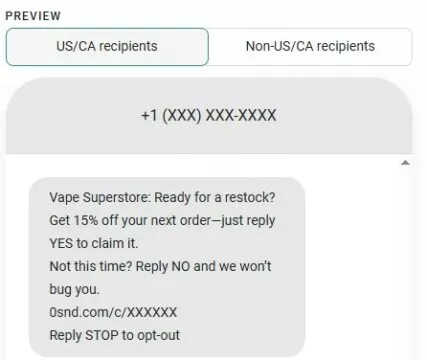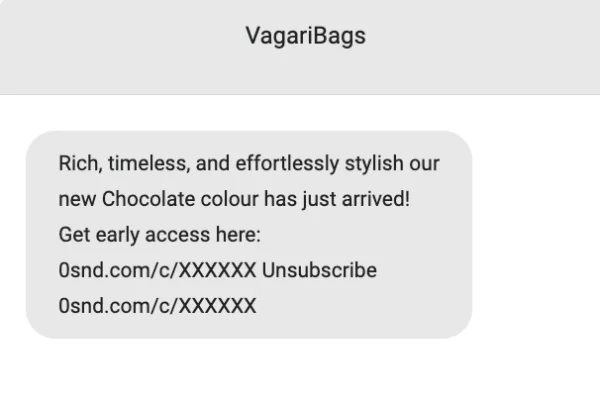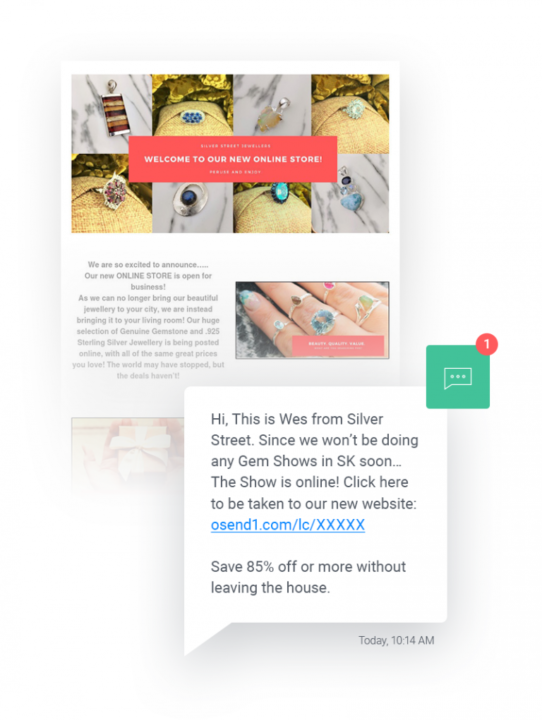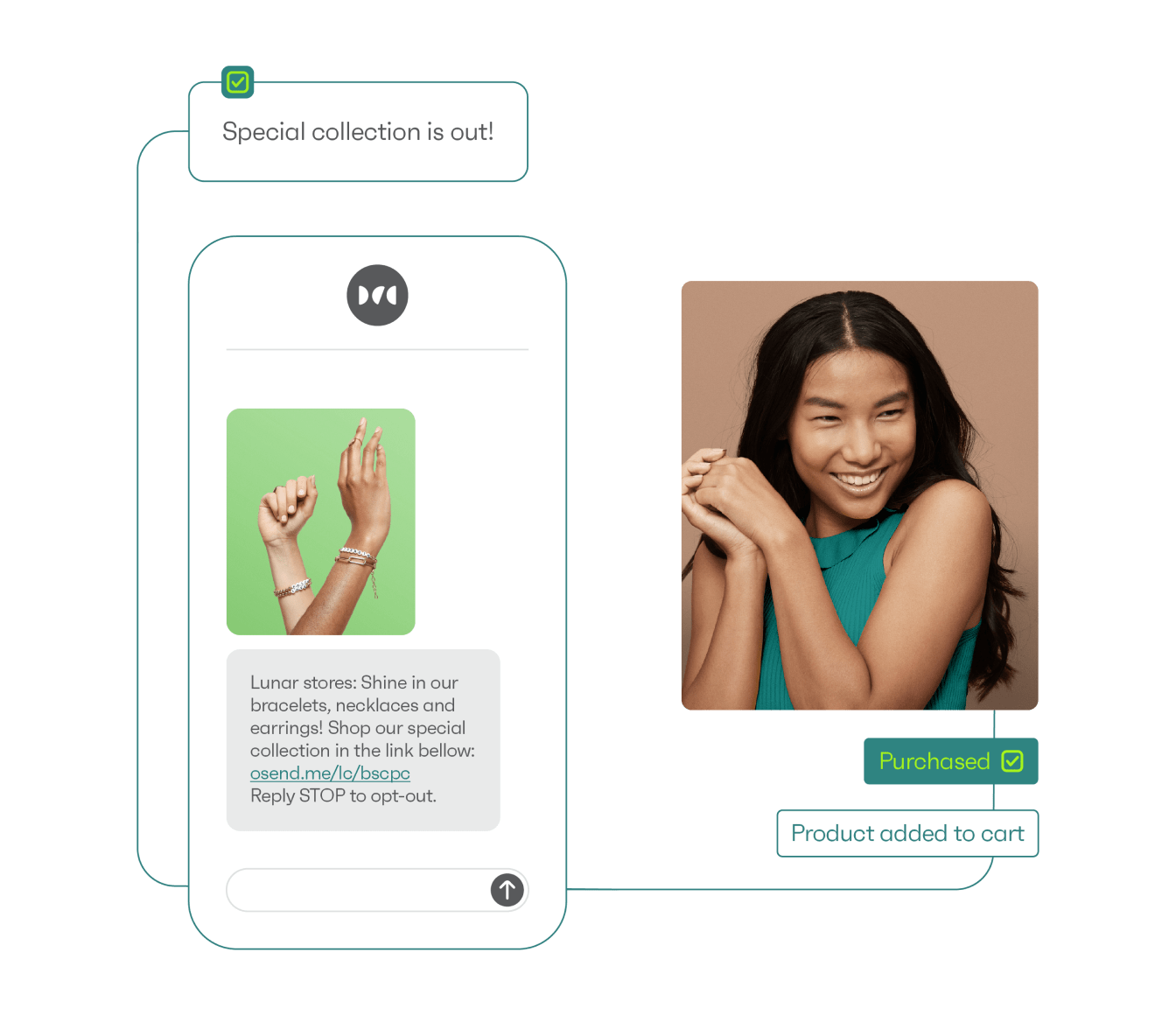
Drive sales on autopilot with ecommerce-focused features
See FeaturesYou won’t build a more receptive audience than customers who opt in to receiving SMS marketing. Its personal nature requires a great deal of trust and willingness to see you in their SMS app, making it potentially your highest-converting channel.
Ecommerce brands sent 31% more SMS messages in 2024 than in 2023, with Omnisend’s US customers generating over $25 million in SMS sales alone.
One such brand is Vape Superstore. “Our customers have received the SMS really well. They appreciate the directness and the immediacy of SMS,” says Head of Digital, Dan Judd. “Anyone who’s got concerns with SMS, at least try it out, I think you’ll be surprised by the results.”
You can build standalone SMS campaigns and automations within some marketing tools, such as Omnisend, which combine email and SMS in an omnichannel approach, triggering messages based on activity, behavior, and more.
Those automations ensure SMS arrives at optimal moments, and according to your customers’ preferences, helping to keep spam complaints to a minimum.
This article provides a complete guide to SMS marketing, including types, benefits, strategies, and best practices for running effective campaigns.
Quick sign up | No credit card required
What is SMS marketing?
SMS marketing is the sending of promotional text messages to opted-in customers who explicitly gave permission for you to communicate with them in this way.
These messages come as plain text SMS or multimedia MMS with images, letting you share flash sales and offers that get seen within minutes of sending.
People guard their phone numbers carefully, so anyone who opts in wants what you’re selling, not just newsletters and updates.
“Your campaigns need SMS to reach your most engaged customers immediately. Add automations, which generated 18% of orders from 9% of sends in 2024, and SMS becomes a significant revenue generator for your marketing.”
—Karolina Petraškienė, Marketing Projects Lead at Omnisend
Main types of SMS marketing
Now that you know what it is, our SMS marketing guide will cover promotional, transactional, and conversational text message differences, plus where each fits into your customer journey.
Promotional SMS marketing
These are your revenue-generating messages, sent on a schedule or in a blast, or via an automation that triggers based on the conditions you set.
For instance, you could build a Black Friday SMS campaign for big spenders and VIPs, and an SMS automation that recovers abandoned carts.
Omnisend customer Kerrits uses abandoned cart texts in its marketing strategy, which generate a 15% conversion rate and an earnings-per-message of $2.87.
Additional promotional texts with high conversion rates include:
- Abandoned checkout
- Flash sales
- Birthdays
- Anniversaries
- Back-in-stock alerts
Of course, these promotional messages fit into your customer journey at different moments. An anniversary message triggers when your customer’s initial subscription date is coming up and targets them with offers. Flash sales, meanwhile, are scheduled.
Transactional SMS marketing
Transactional texts, such as order and shipping updates, are triggered via customer activity and are not marketing opportunities because they are for non-promotional content.
However, post-purchase flows that use transactional information to cross-sell, upsell, and provide personalized offers are marketing texts.
You can use transactional SMS marketing to cover the touchpoints after purchase updates and build a cohesive, pleasant customer experience.
For example, your transactional SMS sequence could:
- Send an order confirmation
- Provide a delivery notification
- Two days later, trigger a cross-sell text with a product that improves the initial purchase
Although these marketing texts aren’t the sales-generating monsters that promotional SMS messages are, they can improve your brand experience, increase customer lifetime value, and form a core part of your retention strategy.
Conversational SMS marketing
Your SMS marketing becomes conversational when you write to the reader and use personalization, such as first names, to make messages friendlier and more relatable.
For instance, this is not a conversational text:
FLASH SALE for three hours. Start shopping: https://yourstorexyz.com/flash
This one is conversational:
Beth, FLASH SALE NOW ON for three hours. Are you ready? Grab an extra 10% off now: https://yourstorexyz.com/flash
Notice how the conversational SMS uses the customer’s name and references their next step, “Are you ready?” That subtle tweak is likely to get a response.
Omnisend lets you personalize conversational SMS with customer names, locations, and custom properties like loyalty points or clothing sizes, and dynamic content like abandoned cart links and order tracking information.
Vape Superstore uses conversational SMS in its marketing strategy, “80% of our online visitors are on a mobile device, so to be able to target those with the instant messaging was a great option,” says Dan Judd. “Combined with email, it was a powerful combination.”
The image below shows one of Vape Superstore’s restock texts:

What are the benefits of SMS marketing?
Ecommerce SMS marketing increases sales and customer lifetime value and preserves your email list for longer, more in-depth campaigns.
Here’s why you should have an SMS marketing strategy:
SMS marketing has higher engagement and conversion rates than other channels
Omnisend’s 2025 data reveals that automated SMS messages make up just 9% of sends but generate 18% of all SMS-driven orders. SMS automations outperformed campaigns with 147% higher click rates and 118% better conversion rates.
In the UK, SMS campaign click-to-conversion rates hit 10.65% compared to the global average of 2.18%, proving some markets respond exceptionally well to text marketing.
Customers see texts within minutes because phones are always within reach. Email requires opening an app, scrolling past promotions, and finding your message among dozens. SMS skips every barrier between you and the sale.
Vagari Bags discovered SMS’s raw converting power after switching from Klaviyo to Omnisend. Co-founder Jake Hughes watched click rates hit 6-7% consistently, with his best campaign delivering a 5.18 return on ad spend:

For every £1 spent on Omnisend’s SMS and email tools, Vagari generates £121.38 in revenue. It uses SMS marketing for product launches and exclusive offers, while email handles storytelling.
“Everyone has their phone on them. It’s direct, it gets opened, and it drives action,” says Jake. He plans to expand SMS into cart and checkout automations next.
SMS marketing offers direct and personalized communication
SMS lands in the same place customers check hundreds of times a day, sitting next to conversations with people they know.
While email remains essential for detailed product information and visuals, SMS cuts through and arrives where customers already pay attention.
Personalization takes things further and doesn’t end at using their name. It also means showing up when they’re already looking to recommend products and provide discounts.
According to Statista, consumer preferences for personalized and contextual SMS messaging are growing, something “Žalgiris” Kaunas basketball club capitalized on to turn 9,000 fans into SMS subscribers within a year.
Žalgiris generated 39% of its ecommerce revenue from its combined email and SMS program. It didn’t treat SMS like another advertising channel. Instead, it sent game updates and merchandise drops as insider information that fans wanted.
Marketing Director Ignas Vyšniauskas says SMS worked because it matched how fans communicate about basketball – quick, direct, and in-the-moment. When it launched its “Žalgiris Street” collection, texts went out immediately to subscribers who bought within hours.
“SMS is your most effective channel for shaping customer behavior. Its contextual messaging capabilities and personal delivery exponentially increase the likelihood of engagement.”
—Karolina Petraškienė, Marketing Projects Lead at Omnisend
SMS marketing complements email for better results
Email and SMS together generate more revenue than running either channel alone because customers engage with each format differently throughout their day.
Email provides space for product images, detailed descriptions, and multiple offers. SMS delivers the urgent reminder when customers are on their phones, ready to buy, usually hours or days after ignoring the email.
Appropriately combined, you capture sales from customers who would otherwise never see your message or forget to complete their purchase.
Silver Street Jewellers provides one of our favorite SMS marketing examples. It discovered the power of channel combination after moving online during COVID-19.
It sent texts saying, “Hey, check your email. Just sent you some awesome coupons!” and watched its traffic spike immediately. Here’s another text example:

Its automated emails generated $4 in revenue per email, but SMS reminders were needed to bring customers back. Within three months, it made $100K online with $60K from its email and SMS program. Cart abandonment emails saw a 3,762% revenue lift when followed by text reminders.
SMS wasn’t competing with email – in one of the best SMS marketing trends for revenue, it was rescuing sales that email couldn’t close alone.
SMS marketing provides fast, measurable ROI
SMS generates returns within hours, but tracking them depends on your marketing platform. Omnisend shows every click, conversion, and dollar in real-time dashboards, with customers seeing an average $68* ROI for every $1 spent on SMS marketing.
The primary reason behind this impressive statistic is automated SMS flows, which work continuously to recover abandoned carts, alert customers when items are back in stock, and push flash sales that last hours but generate significant revenue.
For instance, Kate Backdrop hit a 1:300 ROI after switching to Omnisend and using its SMS marketing features to promote sales.
Customer Growth Manager Shan Jiang runs flash sales via SMS that last just up to two hours. “These campaigns encourage immediate action,” she says, explaining how its cart recovery and welcome messages generate consistent revenue.
“Deal of the Day” campaigns include five products at 50% off, pushed via SMS to create urgency. Omnisend’s segmentation lets Kate Backdrop exclude engaged email subscribers from SMS sends, cutting costs without sacrificing sales.
Additional reading
SMS marketing pricing explained: Rates, fees, and ROI
Best practices for SMS marketing
The SMS marketing tips below will give your campaigns the best start:
- Lead with the discount: You have 160 characters to close the sale. Put “30% off” in the first three words, not buried at the end after product descriptions nobody will read.
- Use names: Most marketing platforms, such as Omnisend, let you add names to texts. Doing so makes your tests read as though they come from a friend, which can increase engagement.
- Create FOMO: If your sales, promotions, and offers have time limitations, state them upfront to get your customers to act. Failing to follow this SMS marketing best practice could lead them to click your links after expiry.
- Test discount levels: Some customers need 20% off to buy. Others need reminding about what they left in their cart. Test both message types on small segments first using Omnisend’s A/B testing feature.
- Use email alongside SMS: Email delivers the complete offer with images and details. SMS hits them 24 hours later if they haven’t opened, catching customers where they spend most of their time.
- Respect sending times: Weekdays between 9 AM and 12 PM and 5 PM to 9 PM are top-tier sending times because they are when people shop on their phones.
- Follow opt-out rules: Your SMS tool should handle opt-out language and automatically unsubscribe people, but you might need to configure it to do so. For example, Omnisend includes Reply Stop to unsubscribe for US/CA and an unsubscribe link for all other non-US-CA customers.
Use SMS marketing to start conversations with your customers
You own your SMS list with complete control over delivery, so no algorithm or third-party can dictate when or how your customers see your texts. That provides unbeatable opportunities to sell, nurture, recover revenue, and build trust.
SMS marketing’s immediacy and explicit opt-in requirements build on that value with the pre-engagement factor. Your texts will be seen, and the people viewing them will want to have received them. Can you think of a more willing audience?
However, it also comes with responsibility.
SMS marketing 101 is to have a strategy. It’s no good blasting your customers with one-time bulk SMS campaigns. You’ll do better with appropriate targeting and by taking an omnichannel approach, using text messages as a complementary channel to email.
Quick sign up | No credit card required
FAQs
A $68 ROI for every $1 spent isn’t to be sniffed at (that’s what Omnisend’s SMS marketing customers see). Your results could be five or 20x that.
You can’t send marketing texts to people who didn’t give you explicit permission to send them promotional SMS, including those who handed over their numbers for transactional updates. All messages need an opt-out, too.
Two to three/month is a decent enough volume without annoying people. The last thing you want is to bombard people and fuel unsubscribes.
Our customers have had excellent success with these texts:
-Flash sales
-Restock alerts
-Event extensions
-VIP discounts
-Product cross-sells
Track revenue from SMS clicks within 72 hours and divide it by total SMS costs.
Explore Omnisend, SlickText, Sender, and Attentive. The best, such as Omnisend, treat email as core to SMS success, letting you combine both formats in sequences and reach customers at optimal moments.
TABLE OF CONTENTS
TABLE OF CONTENTS


No fluff, no spam, no corporate filler. Just a friendly letter, twice a month.

 OFFER
OFFER









